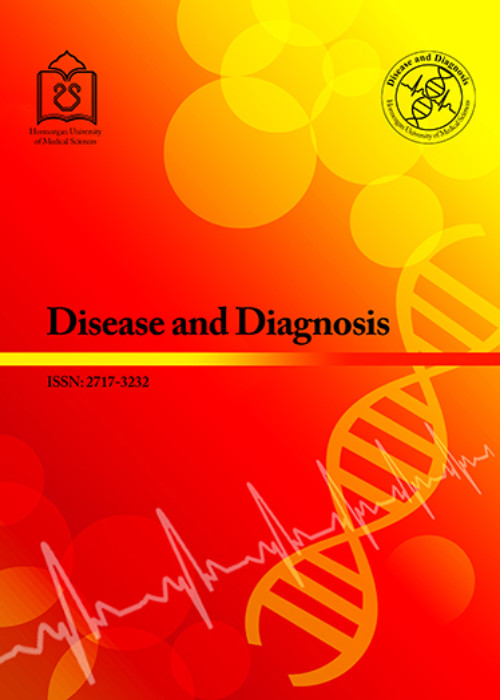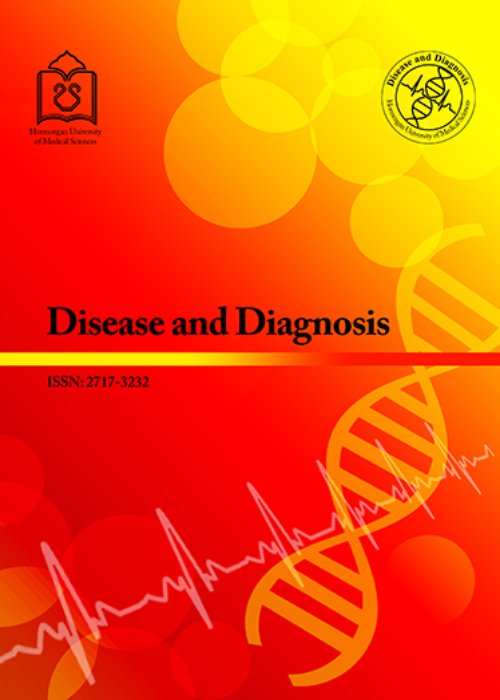فهرست مطالب

Journal of Disease and Diagnosis
Volume:12 Issue: 4, Sep 2023
- تاریخ انتشار: 1402/09/04
- تعداد عناوین: 8
-
-
Pages 156-160Background
Influenza A is divided into a number of subtypes, the most common of which are circulating H3N2 and H1N1. Influenza A and B viruses, which normally circulate in humans (human influenza viruses), are responsible for seasonal influenza pandemics each year. This study evaluated the prevalence of influenza in Hormozgan province and determined the type and subtypes of influenza circulating in the community.
Materials and MethodsThe present study was conducted in a single center on 1237 patients with acute respiratory syndrome and flu-like symptoms in Hormozgan province, Iran from August 2022 to December 2022. Eventually, patients’ data such as the age, gender, and hospitalization rate of patients with influenza underwent investigation.
ResultsOut of a total of 1237 samples of patients, 349 (28.2%) cases were diagnosed with positive influenza and 888 (71.80%) cases were negative. Of 349 cases of positive influenza, 3 and 346 cases were diagnosed with influenza B and A, respectively. The results represented that out of a total of 349 positive cases of influenza, 216 (61.90%) and 133 (38.10%) people were hospitalized and visited as outpatients, respectively.
ConclusionFrom August 2022 to December 2022, Hormozgan province in the south of Iran witnessed an influenza peak with an increase in the prevalence of H1N1 and H3N2 subtypes. The dominant subtype of this peak was H3N2 influenza, but the prevalence of the H1N1 subtype also demonstrated a significant increase. Finally, the cases of hospitalization of patients with positive influenza represented an increase.
Keywords: Influenza, H1N1 subtype, H3N2 subtype, Hormozgan province, Outbreak -
Pages 161-167Background
Brain cancer is recognized as one of the deadliest cancers due to late detection and limitations of therapies. Glioblastoma occurs in different parts of the central nervous system and is the second leading cause of cancer death in people. There are many problems for the treatment of cancer cells. One of the limiting factors is the resistance of cancer cells to chemotherapy drugs. The use of nanoparticles (NPs) is an effective method for overcoming this problem.
Materials and MethodsFe3O4 NPs were synthesized, and the size and morphology of NPs were determined by transmission electron microscopy, X-ray photoelectron spectroscopy, and Dynamic Light Scattering. The U87-MG cell line was cultured in Dulbecco’s modified Eagle medium and treated with nano, nano-lomustine, lomustine, and complex with/without magnetic fields. Finally, half maximal inhibitory concentration (IC50), MTT assay, and caspase8 and caspase9 expression were evaluated, and the data were analyzed with SPSS software.
ResultsOur results demonstrated that cell apoptosis increased in lomustine and complex groups, especially with the magnetic field (P > 0.05). Based on caspase9 expression analysis, this rate was increased with the magnetic field vs. its absence (P > 0.05).
ConclusionThese findings indicated that a magnetic field, in addition to reducing the effective dose of lomustine, affects apoptosis with a change in the expression of genes involved in this process.
Keywords: Glioblastoma, Nanoparticle, Apoptosis, Caspase, Magnetic field -
Pages 168-173Background
Transversus abdominis plane (TAP) block is used to manage pain in patients undergoing laparotomy abdominal surgery. This study aimed to investigate the effect of ultrasound-guided TAP block on postoperative pain and complications in patients undergoing laparotomy abdominal surgery.
Materials and MethodsIn this randomized double-blinded prospective clinical trial, 64 patients undergoing laparotomy surgery were selected based on inclusion and exclusion criteria and were randomly divided into two groups with 32 patients in each group. General anesthesia was induced in all patients. At the end of the surgery, a TAP block was performed under ultrasound guidance in the intervention group, and the control group received no intervention. The severity of pain was assessed 2, 6, 12, 18, and 24 hours after surgery using visual analogue scale (VAS) criteria. Patients who scored their pain more than 4 on the VAS for pain relief received 25 mg of intravenous (IV) pethidine. Furthermore, potential complications, including nausea, vomiting, and dizziness were assessed and recorded in both groups.
ResultsMean pain severity 2, 4, 6, 12, 18, and 18 hours after surgery was significantly lower in the TAP-block group than in the control group (P = 0.001). The mean dose of pethidine received in TAP block patients was 28.90 ± 19.16 and 60.93 ± 14.11 in the control group, which showed a significant difference (P = 0.001). Moreover, the mean time to the first dose of pethidine in patients in the TAP block group and the control group was 15.36 ± 3.56 and 8.43 ± 4.28 hours after surgery (P = 0.001). In addition, the incidence of nausea and vomiting was lower in the TAP group than in the control group.
ConclusionUltrasound-guided TAP block can control post-laparotomy pain and reduce opioid use during hospitalization.
Keywords: Ropivacaine, Laparotomy, Transversus abdominis plane block, Anesthesia, Pain -
Pages 174-179Background
Follistatin-like 1 (FSTL-1) and leukemia inhibitory factor (LIF) are two myokines that are affected by overweight and have inflammatory and damaging effects. Considering that exercise reduces excess weight, this study aimed to evaluate the effect of aerobic and resistance training on FSTL-1 and LIF muscle gene expression in rats fed with a high-fat diet.
Materials and MethodsIn this experimental study, 32 rats were randomly divided into healthy control, obese control, obese + aerobic exercise, and obese + resistance exercise groups. The training was performed for 4 weeks at aerobic moderate intensity (50-65% VO2max). For resistance training, rats were also trained to climb the ladder (height 110 cm, slope 80%, and the distance between the bars of the ladder 2 cm), which is based on the determination of one repetition maximum. A high-fat diet was prepared with 40% fat, 13% protein, and 47% carbohydrates and continued until the rats reached the obesity range. The tissue sample was taken from the gluteus muscle.
ResultsThe expression of FSTL-1 and LIF in the obese control group increased significantly compared to the healthy control group (P = 0.044 and P = 0.039, respectively). The expression of FSTL-1 and LIF in the resistance training group significantly decreased in comparison to the obese control group (P = 0.049 and P = 0.046, respectively). There was no significant difference between the aerobic exercise group and the obese control group (P = 0.053 and P = 0.059, respectively). However, a significant difference was observed between aerobic and resistance training groups in terms of FSTL-1 (P = 0.042).
ConclusionResistance exercise seems to have a greater and better effect on FSTL-1 and LIF in the muscles of obese samples compared to aerobic exercise.
Keywords: Exercise training, Myokines, Obesity -
Pages 180-186Background
Uterine natural killer (uNK) cells have a significant impact on pregnancy and related complications. Given the importance of receptors in the activity of uNK cells, the present study aimed to determine the number of uNK cells and NKp46 (one of the most important NK cell-activating receptors) expression in the endometrium of women with recurrent miscarriage (RM) or a history of in vitro fertilization (IVF) failure.
Materials and MethodsThis case-control study was performed on 48 participants, including 16 healthy controls, 27 cases with RM, and 5 cases with repeated implantation failure (RIF) during the mid-luteal phase according to a standardized diagnostic protocol. All participants were assessed using transvaginal ultrasound to determine embryo survival rate and confirm gestational age. Endometrial specimens were collected and subjected to immunohistochemistry (IHC) staining using an anti-human NKp46 antibody expressed by uNK cells.
ResultsA significantly higher number of cells positive for NKp46 was obtained among two groups of cases versus healthy subjects (patients: 1.46 ± 0.78, controls: 0.82 ± 62, P = 0.006), and the number of CD56 + cells was significantly higher in patients than in controls (patients: 18.14 ± 7.14, controls: 11.71 ± 6.17, P = 0.003). Additionally, there was not a significant difference in the frequency ratio of NKp46 + NK cell subset to CD56 + uNK cells between the patients (P = 0.59) and control healthy group.
ConclusionThe increase in the number of uterine NK cells and their cytotoxic activity during implantation and early pregnancy, possibly resulting from an excessive expression of inflammatory cytokines, confirms a significant association between uNK cell activity and a higher risk of RM and RIF. Therefore, immunomodulatory treatments may benefit these patients.
Keywords: Natural killer cells, NCR1, Abortion, Recurrent implantation failure, Immunohisto chemistry -
Pages 187-192Background
This study aimed to investigate the effect of 8-weeks of high-intensity interval training (HIIT) with L-cysteine consumption on tumor necrosis factor-alpha (TNF-α) and C-reactive protein (CRP) of heart tissue in young rats with type 2 diabetes.
MethodsThe statistical population of the present study consisted of young (4 months) rats with type 2 diabetes. Ten rats were selected as a healthy group, and 40 rats became diabetic. Diabetic rats were randomly divided into four groups: diabetes control, diabetics with training, diabetics with supplements, and diabetics with training + supplement. Moreover, high-intensity interval exercises were performed 3 days a week for 8 weeks, and 500 micromoles of L-cysteine were administered daily.
ResultsThe training + supplement group had significantly higher TNF-α levels compared to the diabetic control group (P = 0.002). The diabetic control group (P = 0.001) and training group (P = 0.001) had higher TNF-α levels compared to the healthy control. The supplement group had significantly less TNF-α compared to the diabetic control group (P = 0.003), while the supplement group (P = 0.019) and the training + supplement group (P = 0.013) had lower TNF-α levels compared to the training group. Moreover, the training + supplement group had lower CRP levels compared to the diabetic control group (P = 0.001), while the diabetic control (P = 0.001), exercise (P = 0.002), and supplement group (P = 0.031) had higher CRP levels compared to the healthy control. Moreover, the training group (P = 0.038) and the supplement group (P = 0.002) had lower CRP compared to the diabetic control group. Furthermore, the training + supplement group had a lower CRP level compared to the training group (P = 0.03).
ConclusionHIIT along with the L-cysteine consumption reduced TNF-α and CRP in the heart tissue of diabetic rats.
Keywords: Type 2 diabetes, Inflammation, High-intensity interval training, L-cysteine -
Pages 193-203
Biochemical anomalies impairing the body’s normal metabolism are referred to as inborn errors of metabolism (IEM). Early diagnosis and management can avert the otherwise harmful situation that may occur due to inborn errors. Generally, their incidence can vary from one case in every 800 to 2500 cases. Thus, understanding the genetic defects behind the clinical presentation of the disease and their early management and treatment is the need of the hour. This review article gives an overall knowledge of the types of IEM, its pathophysiology, clinical presentation, diagnosis, and management of the disease.
Keywords: Inborn errors of metabolism, Genetic mutations, Enzyme, Metabolic defects, Targeted, untargeted metabolomics -
Pages 204-207Background
Brucellosis is a common zoonotic infection caused by the bacterial genus Brucella. It is one of the infectious diseases transmissible between humans and animals, and its clinical manifestations are very diverse and misleading. One of these manifestations is central nervous system involvement, which occurs in various forms. Better and more accurate identification of these diverse clinical manifestations can help physicians in the timely diagnosis and treatment of the disease.
Case PresentationIn this study, we introduce a sixteen-year-old patient who complained of fever, low back pain, dizziness, and headache for two months. A detailed history of our patient revealed previous contact with sheep and consumption of unpasteurized milk. Further clinical tests confirmed the diagnosis of Brucella meningitis in this patient.
ConclusionPatients with brucellosis can show a wide variety of clinical symptoms, and knowing these different clinical forms can help physicians in the early diagnosis of the disease. In a country like Iran, where brucellosis is endemic, any patient who presents with complex and unexplained neurological complaints, especially those with a history of brucellosis, should be considered for neurobrucellosis.
Keywords: Neurobrucellosis, Brucella meningitis, Meningitis, Case report, Iran


